Using a proper fermentation brine is important for successfully fermenting vegetables. While each of my recipes has a recommended salt-to-water ratio, this post provides general information to help you calculate your own fermentation brine ratio.
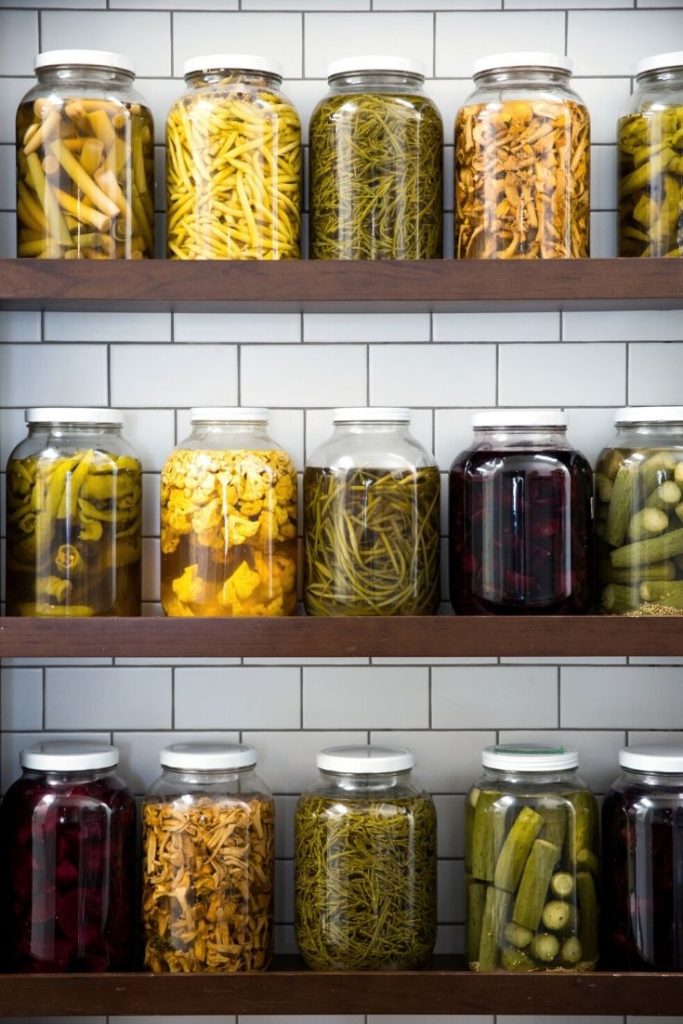
I was inspired to explore brine ratios after my interview with the owner of Agrius. A precise ratio of salt by weight is how they ensure that all their ferments are safe, delicious, and shelf-stable for up to a year.
Having been fermenting for a while, I’ve seen a number of brine ratio charts and calculators. They vary from 2 to 5% salt to water ratios, depending on the type of vegetables. However, Agrius uses a MUCH simpler fermentation brine. Regardless of what they are fermenting, their salt ratio is 2.2% based on the total weight of vegetables and water.
With this ratio, they are able to pack seasonal vegetables into unsealed jars for fermenting and leave them for over a year without any concerns.
Here is how you can bring that level of precision to your homemade fermented vegetables.
Choosing a Salt to Water Ratio
Here are a few things to know when deciding what salt to water ratio to use.
- It is perfectly fine to use any salt ratio from 0% up to 5%. Anything higher than 5%, and you risk stopping the fermentation.
- Ferments with a salt ratio of less than 2% risk going off. However, if you are on a low-sodium diet then it is possible to make salt-free fermented vegetables by using a good starter culture.
- If your vegetables end up tasting too salty, then you can rinse off the brine before serving them, or use them as a salty seasoning in other dishes.
- Precision is not necessary for home fermenters. Pretty much any salt ratio between 2% to 5% will result in delicious and healthy fermented vegetables. It’s fine to taste your unfermented sauerkraut or green bean pickle brine to decide how much salt you need to add.
- Not all salts weigh the same, so unless you’re making your ferment by weight, it will never be perfectly precise. And that’s okay. Your great-great-grandparents were probably fermenting based on imprecise measurements, like handfuls of salt and it usually worked out.
- The reason why many books and websites recommend a different salt to water depending on the type of vegetable is that each vegetable has its own mass and density. A whole pickling cucumber is full of water, however, shredded cabbage is much less dense.
2.2% Brine
Agrius’ salt to water ratio of 2.2% works for everything from sauerkraut to fermented pickles because it takes into account the weight of the vegetables as well as the added water.
Here’s how to use this ratio in your own home. It’s easiest if you have a digital scale, but if (like me) you don’t, then I have a chart based on jar sizes that provides a fairly good estimate.
Fermentation Brine Calculator
The easiest way to calculate the amount of salt required for your fermentation brine is to use a digital scale.
Here are the 7 steps to calculating the required salt by weight using a digital scale.
- Weigh your jar. Write down the weight.
- Fill the jar with your vegetables, spices, and anything else you’re going to use for the ferment. Add water, to cover.
- Weigh the jar again.
- Calculate the total weight of water and vegetables by subtracting the filled weight from the original weight. Alternatively, if you happen to have two jars that are the same, use an empty jar to zero your scale, then weigh the full jar.
- Take your jar off the scale, then use the scale to weigh out 2.2% of salt by weight. Use the handy calculator below to help you calculate 2.2% of your original weight.
- It’s fine to add the salt directly to the jar. Give it a stir to dissolve the salt.
- Put on the lid and leave the vegetables to ferment.
If calculating 2.2% of something isn’t your strong suit, then here is a handy calculator. It’s not super fancy, just a bit of code that Brad wrote for me. I recommend using grams because they’re easier to deal with when using really small amounts.
Total weight of vegetables and liquid grams / ouncesSalt required for 2.2% brine grams / ounces
Fermentation Brine Chart
After breaking two digital scales, my sister-in-law bought me a traditional cast-iron balance scale, so I can’t use the method above. Instead, I borrowed a digital scale from a friend and calculated a rough guide of how much salt to add for common jar sizes with three types of salt: flaked pickling salt, medium-fine pink Himalayan salt, and extra fine sea salt.
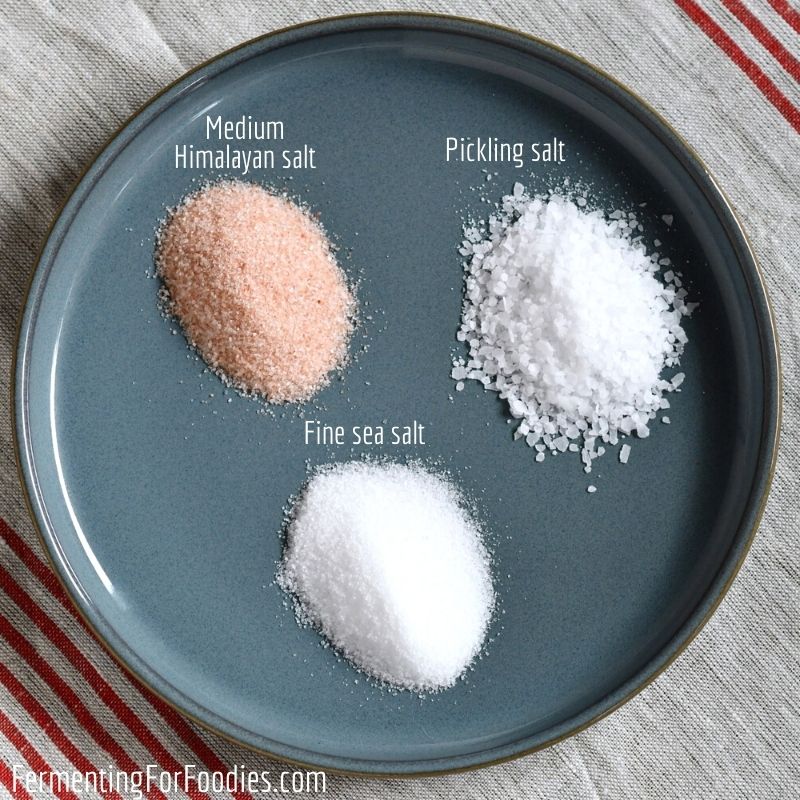
Here are a few notes for anyone planning on using this brine chart:
- As it turns out, the sea salt and pickling salt, weighed the same amount. The pink Himalayan salt was a bit heavier. So I created my brine chart based on the weight of flaked pickling salt or fine sea salt.
- Depending on the type of vegetable, it may result in a slightly salty brine, because not all vegetables have the same density. However, it’s a pretty good approximation. (If you want to double-check my math, I’ve got the steps I used set out below the table).
- One last note… I personally like my ferments a little less salty than a ratio of 2.2%. So most of my quick-to-eat ferments are actually about 2% brine. However, if I want to stash something in my closet for more than a few weeks, then I always go with at least a 2.2% brine.
| Jar Size | Salt |
| Half-pint (236 ml) | 3/4 tsp |
| Pint (473 ml) | 1 1/2 tsp |
| Quart (946 ml) | 3 tsp |
| 500 ml (16.9 oz) | 1 5/8 tsp |
| 1 L (33.8 oz) | 3 1/8 tsp |
| 1 1/2 L (50.7 oz) | 4 3/4 tsp |
How I created the chart
Here are the steps I took to figure out how much salt to include for each jar size.
- I started by weighing how much water would approximately fit in a one-quart jar. It’s less than the expected 946 g because it’s important to leave headspace for bubbling. So it actually came out to 915 g.
- Then I used Brad’s handy calculator to figure out how much salt was needed for 915 g. It came to a nice and even 20 g. (How lucky was that!)
- Then I compared the weight of water to the weight of a few different types of ferments. For example, a quart of sauerkraut weighed 853g, requiring 19g of salt. A quart of beets weighed 964g so it would need 21 g of salt.
- I’ll admit that rounding is never perfect, but 1 gram of salt is very little. So I decided that 20 g of salt would be a nice happy medium for a quart-sized jar.
- Next, I weighed the three types of salt to figure out how much was needed for 20 g. The pickling salt and fine sea salt both needed exactly 3 tsp. The medium-fine pink Himalayan salt needed a bit more than 3 tsp.
- Thus, for those of us who don’t have a scale at home, we can use a rough ratio of 3 tsp of salt per quart size jar. It might be a bit salty for sauerkraut (2.5% brine) and a bit less salty for pickled beets (2% brine). But on average it will be nearly just right.
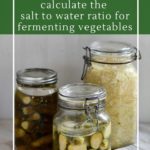

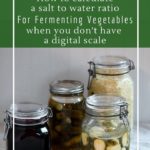
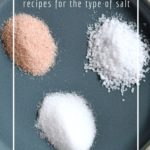
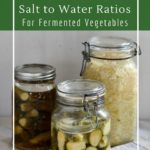
tsp (t) = teaspoon
Tbsp (T) = tablespoon
do you really mean 3 tsp per quart? that would be 1 tablespoon, would it not? seems not enough.
Hi! I do mean 3 tsp (1 Tbsp) per quart. That’s not per quart of water, but rather per quart-sized jar of vegetables and water. You could use slightly more salt without stopping the fermentation, however, the resulting vegetables would be quite salty. Cheers!
Hi Emille, I like your precision and understanding, which is above the usual I find on the www. A roughly 2% solution, as you say works most the time, and by that I mean that the weight of salt is 2% the entire weight of the jar contents – veggies plus water. But I can’t get it to work for cucumber pickles, and in order to prevent the white mold that forms, I need maybe twice that concentration. I’ve seen suggestions as high as 5%. The reasons for such differences are complicated, as you indicate, and the water concentration of the veggie probably affects it. Also, different veggies will probably form different lactic acid bacteria and the time required to build up enough lactic acid varies. For instance, mustard greens and garlic take a very long time for the fermentation process.
Interestingly, some Asian recipes call for the use of starchy rice water, for instance when fermenting mustard greens. I wonder if that’s a way to compensate for the long fermentation times, assisting the bacteria. With all these things, the more experience the better, but in the main, it’s all remarkably simple, and it amazes me that Nature has provided for such simple methods that allow us to enjoy such a complex chemical factory in our bodies.
Hi Tom, That’s interesting that the 2.2% salt won’t work for cucumbers for you. It’s roughly the ratio for both of my fermented cucumber recipes. I’ve been making them for years using this ratio. They do get a white powdery dusting in the jar, which is spent yeast (in the jars that ferment for several months). Or if I do open-air fermenting, then I have to remove the scum.
I can imagine the starchy rice water might help provide the sugars needed to kickstart fermentation? Hum, I haven’t tried it though. Sometimes I add a wee bit of vinegar to speed up the acidification of the ferment, which can help the acid-loving Lacto-bacteria.
Cheers!
I agree with Tom and I’ve seen quite a few internet articles that call for 5% salt for cucumbers. I tried 1 tbsp per quart with a starter and filtered tap water and it molded every time I tried it. You may want to reconsider your stance.
BTW I do mean mold as in the black kind and not Kahm. I don’t mind scooping off white powder. But I’m told mold has invisible tendrils that go deep into the ferment so scooping doesn’t remove it all.
Sorry to hear about your issues. It’s always disappointing to discover mold on a ferment.
Using more salt is always fine, as long as you don’t exceed 5%. However, both of my cucumber pickle recipes use 2.2% salt. I usually pack up between 6 to 8 quarts a year, and they last until we finish eating them (usually around May). I’ve never used a starter with cucumbers. I’ve also never seen black mold on a ferment. Maybe I can help?
Is the 1 Tbsp of salt per quart jar or quart of water? The natural water in the cucumbers needs to be taken into account, which is why this ratio is for a packed jar, not just the water.
Luckily, mold can’t penetrate a brine of at least 2%. So unless you’re making sweet pickles, as long as you add 1 Tbsp of salt to the quart jar, the mold can’t grow below the surface.
Here are a few recommendations to prevent mold in your future ferments:
1. If you have black mold in your house, then you’ll always have an issue in your ferment. Pack into fido jars, or jars with an airlock to prevent any possibility of contamination. There’s no need to pop them or check on the ferment. Leave them sealed up and bubbling to prevent problems.
2. Make sure nothing is floating above the brine. Use a weight to keep everything submerged, and skip spices as they tend to float. Mold can’t grow if there is nothing for it to grow on.
3. Ferments need to be left in a cool, dark location. If you can’t get cool (18C/64F) then increase the salt slightly.
Cheers, Emillie
Hi Emillie I used 1 tbsp of salt per jar. I scoop the pureed garlic in first, then dill, then salt. I pack the jar full of cucumbers. Like literally bumper to bumper. Did I try to pack too much in? Then I filled with filtered water to the bottom of the top (the straight part where the lid screws on) so there was about 1/2 inch of headroom. I used glass weight and SS spring on top. I used Kinetic Culture automatic lids. Maybe some dill floated up to the top? I live in an old house with plenty of water damage over the years. Except for my Sauerkraut/Kimchi everything in the house molds. So maybe the salt we use also depends on things like that?
Clearly mold in your house is an issue. It’s rare for cabbage ferments to mold. However, if your lid is a good seal (I assume so, but I haven’t used or seen a kinetic culture lid) then the mold must be in the ferment when you pack it. Maybe try sanitizing your jars and lids? Simply having them sit in boiling water for 5 minutes should do the trick. Feel free to add more salt if that suits you. Cheers! Emillie
I too have seen the many articles about using high salt concentrations, but they are way too salty for me. For cucumbers I like 3.5% of the jar contents weight (water and cucumbers). I ferment for 2-3 weeks at <70 degrees then refrigerate. I use glass weights and air locks. I have never had black mold and rarely get Kahm yeast forming. I test the brine to be below 4.6ph for safe acidification. Mine usually are about 3.1 ph when I finally refrigerate. For what little the weights and air locks cost, why not use them. They mostly eliminate the chance of mold. I currently have 5 half gallon jars and 3 quarts in my refrigerator getting more sour with time. The 2.2% brine seems light on the salt, but I may try it, and watch the ph.
Something else I do which isn't necessary is I drain off most of the brine when fermentation is complete, leaving the bottom crud, and then remove the pickles. I then discard the remaining crud, and rinse the jar with water. Then put the pickles back in the jar, and pour the "clean brine" back in. I don't like the look of the dead yeast and other nasty's at the bottom of the jars.
Thanks for sharing your experience. Cheers, Emillie
Hi Emillie!
I just discovered your blog and I love it! Lots of great info.
I am in Costa Rica, so fermenting at 18C is impossible here. I have heard that for hotter weather, adding more salt is best. Is that true? Any suggestions on this?
Thank you!!!
To be honest, I haven’t looked into it in detail (future blog post maybe?). In general, vegetables will ferment faster in warm weather. So I usually only ferment things for about 1 week in the summer. If you want to use fermentation for long-term storage, then increasing the salt is probably a good idea. You can easily double the amount provided in the blog post and it will only be 4.4%. However, that would be quite salty. So maybe just add a bit extra salt? There’s really a lot of leeway between 2% and 5% brine ratios. Good luck!
Veronica, could you dig a deep pit? The deeper you go into the earth, the more medium the temperature. For example, at 6 ft it may be 60F year round. The Asians do that for a lot of their ferments.
I love this idea! Thanks for sharing.
Great post – salt has always been a challenge for me! I have a question about this line:
“…With this ratio, they are able to pack seasonal vegetables into unsealed jars for fermenting and leave them for over a year without any concerns…”
Does this mean in the fridge or on a shelf?
Thank you!
On a shelf… 🙂 The first time you do it is exciting… but usually if something is going to go moldy it does it in 1 week… if not, then it can last for months. Cheers!
Are there vegetables for which you might be inclined to use a somewhat saltier brine and others for which you might be inclined to use a somewhat less salty brine? If so, what would determine when to use a more or less salty brine? Thanks!
I pretty much use the same overall salt ratio for all vegetables… however, the brine may be more or less salty depending on how much water is in the vegetables. For example, I have a recipe for fermenting whole heads of cabbage in my cookbook. That uses an extra salty brine to account for the mass of the cabbage. Hope that answers your question! Cheers, Emillie
Thank you!
I am a “newbie”, I am on my 3rd batch of sauerkraut, the first batch was amazing. I decided to make another batch with purple cabbage, it was nasty. I have wondered if you need to sterilize the vessel you use? Can you just put the vessel in the dishwasher? What do you use to hold the goods down? How much space do you need to leave at the top? I have been successful with pickles and jalapeños, not knowing what I was doing. I cannot wait to try more, trying to learn.
Sorry that your purple cabbage kraut didn’t work out. I’m guessing it’s not because of the flavor, but rather that the wrong culture grew in it. In that case, I do recommend sanitizing your jar the next time around. The easiest way is to pour boiling water into the jar and let it sit with the boiling water for at least 5 minutes. Otherwise, I usually handwash my jars (because I don’t trust my dishwasher not to chip my beloved fido jars). But I put my regular mason jars in the dishwasher because they’re less precious!
I have actual mason jar weights to hold everything down in the ferment. Before I had weights, I used smaller jars as weights. Eg. a jam jar works as a weight in a wide-mouth mason jar. Lastly, I recommend leaving quite a bit of room at the top of your jar of sauerkraut. It will bubble up WAY more than pickles. In a quart-sized jar, leave about 1 inch of room. (2 inches in a 2-quart jar, etc.)
Hope this helps! Happy fermenting!
Yes, I agree with Emilie. I use purple cabbage exclusively for my Sauerkraut. As an added bonus, it’s a built in litmus test. In neutral pH the color stays purple, in alkaline pH, the color turns blue, in acidic pH the color turns red. If it ain’t red, don’t eat it.
I also use a wet brine with starter culture and olive leaf extract for mine. I top with a cabbage leaf, glass weight and SS spring. My lid is self venting and I vacuum out the air before setting aside. I have yet to make a bad batch of Sauerkraut. Although mine is more a fusion with kimchi. Purple cabbage, rainbow carrots, daikon radish, pureed garlic (do first and let sit while working), pureed ginger, crushed red pepper or Korean gochugaru and salt. I fill 4-6 half gallon Mason jars and let sit for 3 weeks
Sounds delicious!
OMG you have no idea! All these years my body kept craving for salty and tangy. So, I gave it store bought pickles. Then I started to learn about nutrition from the “dirty dozen” and discovered fermentation.
I will NEVER EVER go back to vinegar made pickles or Sauerkraut. Lactic acid fermented food has a milder bite IMO so I can afford to spice it up. Seriously sister, I can sit down and eat it by the pint.
When it’s done fermenting, I store it in a half gallon Tupperware. When I eat it I have to avoid just scooping it out of the Tupperware. That’s to avoid contaminating the batch with oral bacteria. I’ve been able to store batches in the fridge for months being disciplined like that. But it tastes so good it’s almost addictive!
Hi Emillie, I am very new to fermenting and I have the springs and fermenting lids but I’m still confused in few areas. One, how long do you ferment in a dark cool room, I usually only leave it about a week and my batches seem fine but I have read some leave it for up to 3 weeks? Second, after that I take my fermenting lid off and but a regular lid on but does it have to go in the fridge now? Once you open it to start eating it I’m sure you put it in the fridge but does it need to stay in the brine in the fridge?
Hi Corrie,
It’s fine to eat your ferment after 24 hours, or several months later. 🙂 Fermented vegetables will be sweet if eaten within the first 3 days. After that, they become more sour. More sour doesn’t mean more probiotic, so feel free to enjoy them whenever you want. The ferments that I leave in my dark closet for several months are all in their original jars with the original lids. Most of mine are in fido jars, but I had a lot of produce to pack this fall, so I have a few regular canning jars in there too, with the lids loosely tightened to allow CO2 to escape. Those all have weights so that if I get mold on them, the vegetables will still be safe to eat. However, they all look good. Phew!
Changing the lid or opening the jar increases the risk of contamination. So when you open the jar to start eating them, keep them in the brine in the fridge. Depending on what you fermented the brine may not keep the pickles fully submerged as you eat them (usually happens with carrot sticks). It’s fine if they are a bit exposed to air, however, it will cause them to brown, so I recommend eating them quickly if that happens.
Cheers, Emillie
I am thankful that I found your website. It finally answered my questions about salt amount and water, etc. This article is very clear in the method and such. Thanks so much!
Glad it was helpful! Cheers!
Very interesting and good information for those looking to find simple ways to ferment vegetables.
You sure have done it easy. Thanks
Can too much salt cause mold ?
Typically salt is used to prevent mold. However, too much salt also kills Lactic bacteria, which might increase the risk of mold floating on top of a ferment. However, mold cannot live in a salt brine. Does that help answer your question?
Cheers, Emillie
I sometimes get mold with a 3% total salt weight
You recommend 2.2% that is why i ask
Personally i think its spices floating on top. i ferment in ball jars with no weights. I think if i keep everything under the surface EVERY time i should be fine
Thanks for your reaponse
It’s definitely the floating spices that are causing mold. If you are enjoying fermenting, I recommend investing in a few good-quality jars (fido, air-lock, etc.) It really reduces the risk of mold. And they last for a long time. I’ve been using my fido jars for over 10 years!
Happy fermenting! Emillie
One more question please.
If i use a fido jar, close it completely for fermentation and thats it? Set it and forget it?
Or do i need a weight, weight it down, dont close completely, then close after fermentation ?
Thanks for your help
Yes, you don’t need a weight with a fido jar. However, I often use one anyway if the food is floating. Otherwise the ones that are above the brine tend to brown. Depending on what I’m making, the weight is often a longer piece of vegetable that can be shoved down under the curve of the jar. Like a cabbage core, carrot stick, longer cucumber, etc. Cheers!
I’ve only done one ferment, cabbage with carrots which turned out delicious. Unfamilar with salt to water ratios. I want to do a 1/2 pint of garlic but honestly am challenged in figuring out ratios. Saw a chart that said 3% brine for garlic & another suggested using 1 3/4 tsp. salt. Wanted to try other foods but now hesitant. Don’t want to invite unfriendly bacteria into my body.
Brine ratios can be confusing depending on how people are calculating them. Many people calculate them based on the type of vegetable and amount of water. (Because some vegetables are more dense, etc.)
I prefer to do it by jar size. That way the ratio is the amount of salt based on the total amount of everything (water + vegetables) in the jar. It is always the same for a particular jar size and ensures a safe ferment.
This calculator is based on 2.2%. If you want to do 3%, then you’ll need to increase the amount of salt by 1/3. For example, instead of 1 Tbsp in 1 L jar, you’ll use 4 tsp in a 1 L jar. Does that help?
Cheers, Emillie
Ok, I don’t have a digital food scale and the jar chart won’t work since you have to add salt directly to cabbage before you know how much will fit packed into one jar…. I have been doing 3 tsp salt per 800 grams of cabbage. To make it 2.2%, If all my convoluted math is right, per your calculator saying 17.6 grams of salt per 800 grams of cabbage, this would be 2.5 tsp? (I’m using Morton’s canning and pickling salt) I know it’s not as accurate as weighing the salt, but roughly?
Hi Dustin, That would be right, if you don’t add any water to the jar. I usually throw a two tablespoons of salt on the cabbage (assuming it’s a large cabbage). Then when I fill the jars I adjust the salt, as needed. So if I ended up needing more salt for the jar size, I would sprinkle that on top. It will only be a little bit, and it will dissolve as you pack the cabbage into the jar and it ferments. I also sometimes top up with water for the same reason. Basically, I’m adjusting my kraut to fit the jar. 🙂
I borrowed a digital scale for this post, and weighed all the types of salt. The difference between them was negligible. Just don’t use rock salt.
Cheers! Emillie
Prefect, thank you, my kraut is coming out good. I think I just over salted 3 jars of veggies. I made three 1 qt jars. 1 is carrots and two are green beans. I needed about 6 cups of water in total to cover all three jars. To make the brine, I used 1 TBSP salt per cup of water so 6 TBSP all together for 3 jars. Shouldn’t it be more like 1 TBSP per jar? I thought your recipe said 1 TBSP salt for one cup of water for brine so I’m confused. Is this way too salty?
Ok it’s obviously way too much salt. I am dumping the brine out of the jars and making a new brine using 2 Tsp salt per jar (from your veggie stick recipe.) the veggies probably still have residual salt, too lazy to unpack and rinse, so I’ll hope for the best. Failure is part of the journey
Hi Dustin, That will be about 4.4% salt… not too salty to ferment, but maybe too salty for your taste buds? I usually dissolve 1 Tbsp salt in about 1 cup of water. Then I cover the vegetables with more water, as needed. The exact amount of water required will depend on the vegetables and how tightly packed they are. I’m just finished up some fermented tomatoes that didn’t need any additional water. (I squeezed them right into the jar so they were packed in there). However, something like carrot sticks may need more water. It really depends.
There are a few things you can do if you want to reduce the salt in a too salty ferment. You can remove some of the brine and add more water. Or you can just add those vegetables to a bland recipe. They’re a great way of adding the salt to your meals.
And I love your attitude around failure! My friend who works in education always say fail stands for First Attempt In Learning. 🙂 Cheers, Emillie
Hi Emilie,
My last batch of regular green/white cabbage sauerkraut (2 jars) each have the same weird aftertaste. No other signs of failure. Kraut tastes good at first but has weird after taste. Not terrible, but off enough that I don’t like to eat it straight. Only in salads and soups. I already ate a whole jar so it’s not toxic. Any clue why? I did order organic cabbage and discovered later it was not organic but I don’t think that’s it. One jar was fermented a little over 2 weeks the other a little over 3 and both taste the same.
Hi Dustin,
I usually leave my sauerkraut for longer than 3 weeks. Often, I leave it for months before I get around to eating it. However, fresh kraut sometimes has a flavor that seems almost soapy. It’s not quite sour, but it’s not sweet either. Maybe you need to let it ferment for a bit longer? If you’ve added any additional flavors (spices, vegetables) that may be part of the strange taste?
Cheers, Emillie
Yeah I’m going to start letting my ferments go longer. I have been doing that incrementally. My kraut is only salt and cabbage so no added flavors. Well, this kraut wasn’t as good as my first batch but it certainly could have been worse!
Hum… in that case, it must be due to the cabbage. I pretty much always flavor my kraut, so I might not notice that sort of different. Cheers!
Thanks. This helped. I’d started some Asparagus fermenting, but had wanted a lower sodium content version, so I’d used only 1%, but I was a little concerned, so I wanted to make sure it would be safe, and, apparently, it wasn’t–I poured a little of the brine out, dissolved enough salt to bring the total to 2.2%, and now hopefully it should be fine.
Glad this was helpful! I have a post on how to make a low-sodium sauerkraut. All of the advice will work for your asparagus (and other ferments). I completely understand wanting to have less salt in your ferments. Here’s how I do it safely. 🙂 https://www.fermentingforfoodies.com/how-to-ferment-low-sodium-sauerkraut/